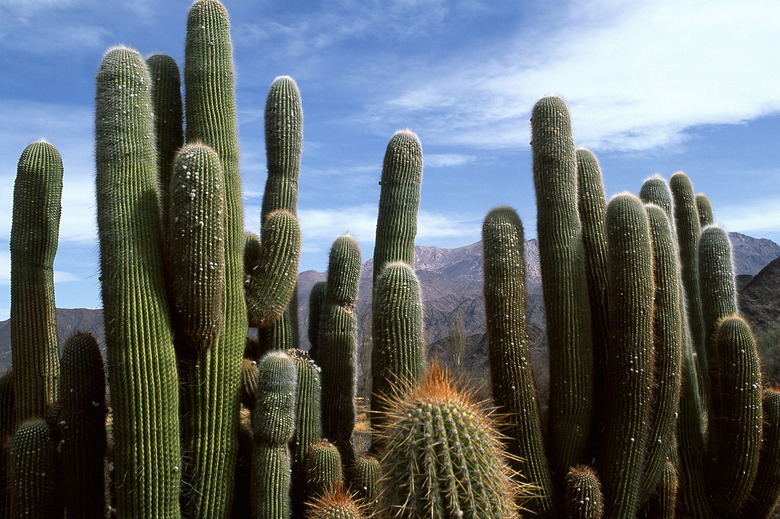How Do I Identify An Ecosystem?
An ecosystem, all the interdependent living and non-living things in an area, is the basic ecological unit for supporting life. National Geographic calls it "a bubble of life." An ecosystem must provide everything its inhabitants need to live and reproduce: sunlight, food, water, air, nutrients, a place to live or grow, others of their own species. Many diverse ecosystems exist on Earth — deserts, forests, grasslands, lakes, mountains, oceans and many subcategories within those types — and they can be identified through some basic features.
Dominant Geographical Features and Climate
Dominant Geographical Features and Climate
The characteristics of an environment — climate, latitude, soil type, soil or water chemistry, altitude and topography — determine what kinds of life can exist there. At the extreme north and south latitudes on Earth, the Arctic and Antarctic ecosystems, little solar radiation means bitterly cold weather, little plant life and only cold-tolerant animals. A desert ecosystem, with its intense heat from the sun and lack of precipitation — often due to mountain ranges that prevent the influx of moist air — hosts only plants and animals that have evolved moisture-preserving and heat-tolerant adaptations. Mountain ecosystems vary depending on their altitude, which influences average temperatures and precipitation; but many mountain plants and animals are adapted to withstand high winds, colder weather and steep terrain. Tropical rainforests exist in warm latitudes with abundant rainfall and support a great diversity of plants, invertebrates, amphibians and other life. Temperate rainforests grow in temperate climates between ocean coasts and mountain ranges, providing them with ample precipitation and fog and supporting the growth of huge trees, lush vegetation and high biological diversity.
Dominant Vegetation
Dominant Vegetation
Different kinds of ecosystems feature particular dominant and climax vegetation types. In the low-lying, regularly flooded areas that characterize a marsh, non-woody, water-loving plants such as:
- sedges
- cattails
- reeds
- water lilies
- pondweed thrive
In a desert, succulent plants, often with thorns or other predator-discouraging adaptations, grow sparsely in the sandy soil; thorns in place of leaves also minimizes surface-area-to-volume ratios and thus minimizes water loss. Arctic plants tend to be coated with hair and wax and grow low to the ground to resist wind chill. Only two vascular plant species can survive in frigid Antarctica, in addition to cold- and drought-tolerant lichen, mosses and algae. Conifers dominate boreal forests, where their evergreen needles can photosynthesize even in winter. Wet, warm tropical rainforests boast the greatest diversity of plants and some of the largest trees in the world, all of them competing intensely for light in the lush forest. If an ecosystem is disturbed by fire or other disruptions, vegetation types will change for a while; but usually, over time, its climax vegetation will return.
Dominant Animal Life
Dominant Animal Life
Like plants, the animals living in an ecosystem are uniquely adapted to their environment. Most animals in polar ecosystems, including polar bears, walruses and seals, appear "chunky": they have low surface-area-to-volume body ratios to conserve heat and often have a thick layer of blubber under their skin. With little plant life and huge sheets of ice in Antarctica, many of its animals are ocean-dwelling, warm-blooded and carnivorous. Animals in hot deserts generally appear more slender or elongated, such as camels, lizards and snakes, since a higher surface-area-to-volume body ratio helps to keep them cool. They also have numerous adaptations to help them survive for long periods without water.
Boundaries of Ecosystems
Boundaries of Ecosystems
The boundaries between ecosystems are not always clearly defined. The edges of a pond ecosystem seem quite obvious, but the border between a tundra and boreal forest or a grassland and desert might overlap. In ecosystem transition zones, which can be abrupt or gradual or include intermediary habitats, you will see a noticeable change in the types of plant and animal communities. Mountain ecosystems, for example, might exhibit a gradual change from tall conifers to stubby, wind-blown shrubs to a line above which trees cannot grow. Some species of plants and animals thrive uniquely at the boundaries of two ecosystems, such as shrubs growing at the edge of a forest and grassland, where they receive more sunlight; species diversity can be greater at these edges. Adjacent ecosystems are not discreet, disconnected entities but interconnected as well, exchanging energy, species and nutrients.
References
- National Geographic Education: Ecosystem
- Global Change at University of Michigan: The Concept of the Ecosystem
- Ecotrust: Characteristics of the Coastal Temperate Rain Forest
- Northern Prairie Wildlife Research Center: Wetland Plants and Plant Communities of Minnesota and Wisconsin: Marshes
- The Ohio State University College of Education and Human Ecology: Beyond Penguins and Polar Bears: Plants of the Arctic and Antarctic
- BBC: Bitesize: Evolution
- Indiana Division of Fish and Wildlife: Woodland Edge Enhancement
Cite This Article
MLA
Carter, Kari Norborg. "How Do I Identify An Ecosystem?" sciencing.com, https://www.sciencing.com/identify-ecosystem-11402/. 24 April 2017.
APA
Carter, Kari Norborg. (2017, April 24). How Do I Identify An Ecosystem?. sciencing.com. Retrieved from https://www.sciencing.com/identify-ecosystem-11402/
Chicago
Carter, Kari Norborg. How Do I Identify An Ecosystem? last modified August 30, 2022. https://www.sciencing.com/identify-ecosystem-11402/
